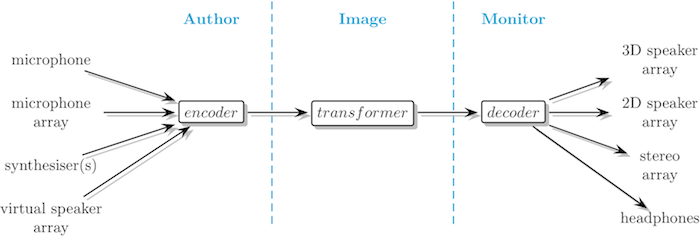Project 3: Ambisonics
Project Overview⌗
For this assignment, you have two options to choose from, both involving ambisonic techniques. See the quick checklist and due date below to align expectations.
Requirements at a Glance⌗
- Due: 10/17/25
- Mix format: First‑order ambisonics (FOA) throughout
- Automation: At least two meaningful spatial automation moves total
- Tools: Reaper with Ambisonic Toolkit (ATK)
- Minimum render to submit: binaural stereo WAV (48 kHz, 24‑bit)
- Deliverables: render(s), consolidated Reaper project, 2‑paragraph reflection
Project A: Original Ambisonic Work⌗
Create an original 1–3 minute ambisonic music, sound design, or narrative fiction piece. Thoughtfully spatialize sources in FOA, considering front‑to‑back depth, height, and immersion. Your work should include:
- Ambisonic Recording: Use the Zoom H3‑VR in Ambisonic mode for one recording.
- Stereo Recording: Include one stereo technique (XY/ORTF/MS) and document it.
- Mono Sources: Allowed; encode to FOA before spatial transforms.
- Automation: Include at least two meaningful spatial automation moves total. These should support the narrative/arc and be visible as automation lanes.
Use the Ambisonic Toolkit for Reaper plugins to mix your project.
Project B: Multitrack Ambisonic Mixing⌗
Alternatively, mix a session from Mike Senior’s multitrack library that includes at least 20 tracks in the source session. You do not need to use all tracks; identify 2–3 focal elements and use spatialization to support them.
- Ambisonic Mix: Encode stereo/mono items to FOA and spatialize within an ambisonic field.
- Automation: Include at least two meaningful spatial automation moves total.
- Performance: Freeze/print heavy FX chains if CPU becomes a problem.
Use the Ambisonic Toolkit plugins to mix the project and document how each tool impacted your creative decisions.
Spatialization Expectations⌗
“Thoughtful spatialization” means:
- Panning and movement choices are purposeful, not random or distracting.
- Spatial decisions contribute to immersion, narrative clarity, or creative intent.
- Depth, height, and rotation enhance rather than overwhelm the listening experience.
Project Setup⌗
For both projects, encode all non‑ambisonic sources to first‑order ambisonics (FOA) B‑format. Then apply ambisonic transforms/panners for spatialization. Finally, decode to your listening environment (binaural, stereo UHJ, or 7.1) on a bus or the master.
FOA format consistency:
- Zoom H3‑VR typically exports AmbiX (ACN/SN3D). ATK tools operate in FuMa (WXYZ) convention.
- Use an AmbiX↔FuMa converter on FOA tracks as needed so encoders, processors, and decoders all match format and normalization.
Reaper routing reminder:
- FOA tracks carry 4 channels. Place encoders on mono/stereo items → FOA transform/panners → send to a master with a decoder.
- Put the decoder on the master (or dedicated ambisonic bus), not per‑track.
- Set master track channel count to 2 for binaural renders, or 8 for 7.1.

Rendering⌗
Render one binaural (for grading) and one 7.1 version of your mix (for us to listen to in class).
Submission Requirements⌗
Submit the following:
- Render(s): Binaural WAV (48 kHz, 24‑bit) and 7.1 render.
- Reaper Project: Use “Save As… → Copy all media into project directory” to consolidate. Zip the folder.
- Naming:
lastname_firstname_ambisonics_v1.zip
- Naming:
- Written Reflection: ~250–400 words addressing some or all of the prompts below. Include at least one screenshot of your session routing/automation and, for Project A, a photo of the stereo mic setup.
- Stereo Recording Technique: Which technique did you use (XY/ORTF/MS)? What was the source? Include a photo.
- Zoom H3‑VR Recording: What did you record and why?
- Automation: Which spatial parameters did you automate and why?
- Plugin Usage: How did ATK (and any converter) shape your decisions? Be specific.
- Challenges & Solutions: What issues arose? How did you solve them?
- Creative Process: How does spatialization serve the piece’s intent?
Common Pitfalls⌗
- Mismatched AmbiX/FuMa order/normalization causing rotated/tilted scenes.
- Placing decoders on individual tracks instead of the master/bus.
- Master channel count left at 2 while auditioning 7.1.
- Skipping FOA encoding for stereo items before spatial transforms.